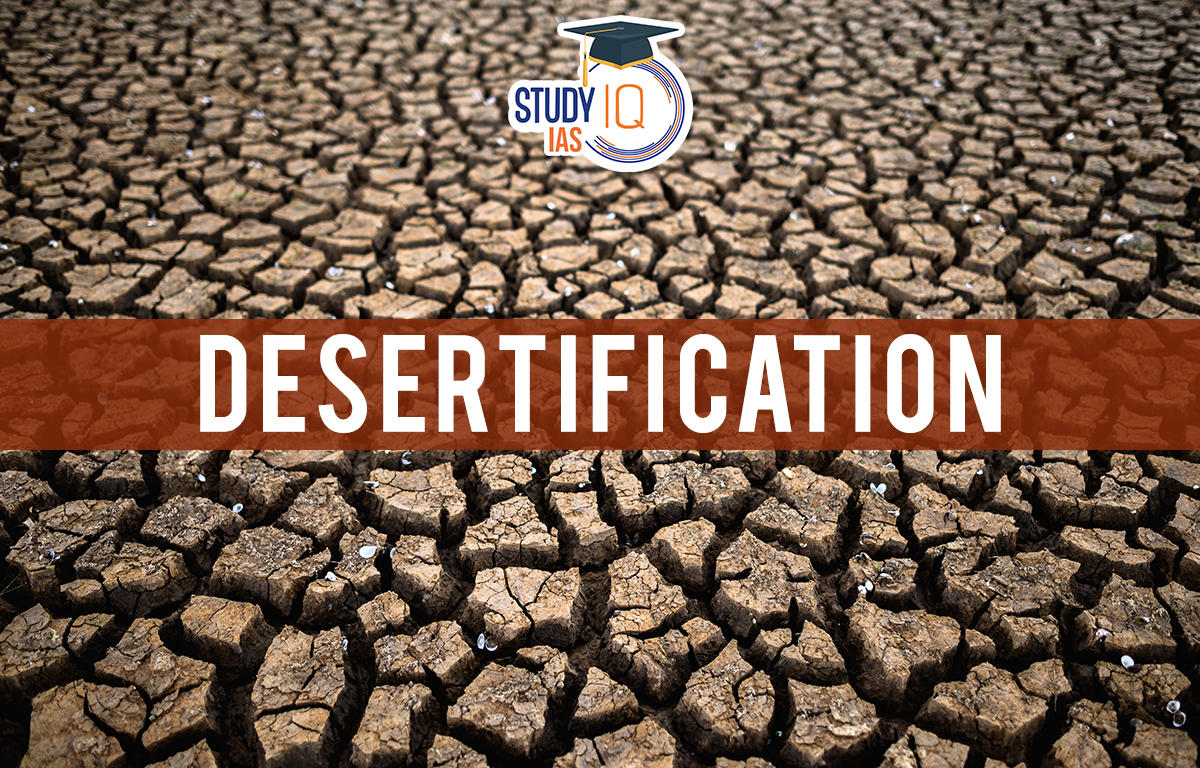Table of Contents
Desertification
Desertification is a form of land degradation in which biological output is lost as a result of human activity or natural processes, resulting in the drying up of fertile areas. It is the expansion of dry areas as a result of numerous reasons, such as climate change and excessive soil exploitation caused by humans.
This article will explain to you about Desertification which will be helpful in preparing the Environment Subject of UPSC syllabus for the UPSC Civil service exam. The UPSC Mock Test can help candidates prepare for the exam with more precision.
Desertification Meaning
As a result of deforestation, drought, climate change, human activity, or inefficient agriculture, rich land can become desertified, losing its natural resources like fauna and flora. This process is known as desertification. Simply said, desertification occurs when the soil on a piece of land is unsuitable for supporting crops, livestock, and wildlife.
Also Read: Land Degradation
Desertification Causes
Desertification results in the extinction of plants and animals as well as the transformation of productive terrain into a desert. The Sahel, Mongolia, Gobi Desert, South America, and other regions have all suffered greatly from desertification. It may be brought on spontaneously or, more often than not, brought on by human activity. Farmers who allow their sheep, goats, and cattle to overgraze cause soil erosion by allowing the local vegetation to wither away. Sometimes, improper irrigation techniques reduce the quality of the soil and cause desertification.
Desert regions are becoming increasingly hotter as a result of the Earth’s temperature being on the rise. These regions typically see more intense weather events and less rainfall. The excessive heat changes India’s environment, resulting in drought, which kills vegetation and trees. All these problems are made worse by rapid population expansion since as the population grows, so does the demand for natural resources.
Desertification Natural Causes
Natural calamities including floods, droughts, and landslides are to blame for soil erosion. As a result, fertile soil is being shifted. Desertification eventually results from this. The Badland Topography is the result of water erosion. This is a step in the process of becoming a desert. Due to wind invasion’s decreased soil fertility, the area is more susceptible to desertification.
Desertification Effects
The productivity of agriculture worldwide, as well as access to clean water and air, are seriously threatened by desertification and land degradation. Through intricate channels, it can have an impact on human health. Food production decreases, water supplies dry up, and communities are compelled to relocate to more hospitable areas as a result of the degradation of the soil and the expansion of deserts in some areas.
The livelihood of a sizable population is impacted by declining agricultural productivity. Global population growth will put more pressure on the environment and result in a shortage of food. Degraded land loses its ability to absorb carbon dioxide (CO2), the main contributor to the current state of global warming and greenhouse gas. Surface and groundwater resources have declined in quantity and quality as a result of land degradation. The region’s flora and fauna are in danger due to the region’s growing desertification.
Desertification’s Impact on Human Health
Malnutrition is caused by insufficient food and water; infections are transmitted by water and food because of bad hygiene and a lack of clean water. Respiratory conditions are brought on by air contaminants and atmospheric dust from wind erosion. It spread contagious diseases spreading when populations move.
Desertification Prevention
At specific soil depths, vacant layers of sand and gravel are formed as salt traps. Salt traps serve to reduce water loss by preventing salts from penetrating the soil’s surface. Improvements to irrigation can stop salt buildup and reduce evaporative water loss. This method involves modifying irrigation system designs to stop water from collecting or quickly evaporating from the land.
Wind and water-borne soil erosion is stopped by cover crops. They can also lessen the consequences of drought locally. On a bigger scale, vegetation can support the preservation of regular rainfall patterns. Perennials or quickly expanding annuals can be used as cover crops. The alternating of various crops on the same piece of land throughout various growing seasons is known as crop rotation. By replacing vital nutrients lost during harvest, this method can maintain the soil’s production.
Rotational grazing is a method of reducing cattle grazing pressure in a certain area. Before they permanently harm the vegetation and soil of any one region, livestock is routinely relocated to different grazing sites. The process of terracing results in several layers of flat land that resemble lengthy stairs cut into hillsides. The method slows runoff, reducing soil erosion and delaying overall water loss.
In contour farming and contour bunding, lines of stones are laid out in accordance with the terrain’s natural rises. These methods aid in capturing and retaining precipitation before it can become runoff. By keeping the soil moist and heavy, they also prevent wind erosion. Windbreaks are made by aligning rows of quickly developing trees perpendicular to the direction of the predominant surface winds. They may also be used to prevent dunes from encroaching, but their main purpose is to slow down wind-driven soil erosion.
The plant population that lives along the dunes’ edges must be protected in order to stabilise the dunes. The root systems underneath hold the soil together, while the plant’s upper sections assist shield the soil from surface breezes.
Desertification UPSC
If allowed unchecked, desertification and the decline of dry land ecosystem services could jeopardize future advances in human well-being and potentially undo some of them. The best chance the world has to lessen the effects of climate change, protect species, and protect human well-being is to stop desertification. People and governments everywhere around the globe have a shared responsibility to protect the planet’s forests. Students can read all the details related to UPSC by visiting the official website of StudyIQ UPSC Online Coaching.





















 WhatsApp
WhatsApp